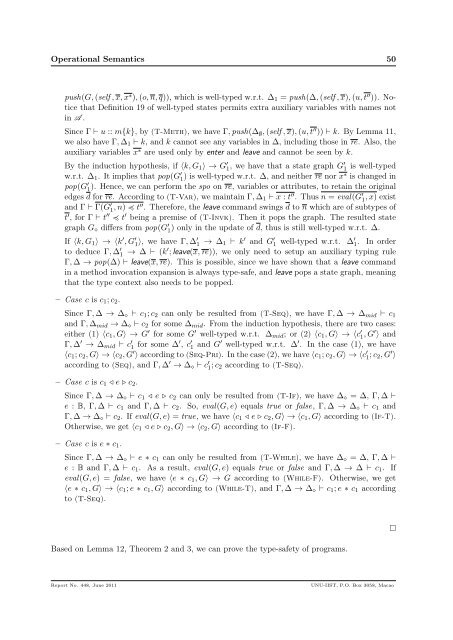A Graph-Based Generic Type System for Object-Oriented Programs
A Graph-Based Generic Type System for Object-Oriented Programs
A Graph-Based Generic Type System for Object-Oriented Programs
You also want an ePaper? Increase the reach of your titles
YUMPU automatically turns print PDFs into web optimized ePapers that Google loves.
Operational Semantics 50push(G, (self , x, x ∗ ), (o, n, q)), which is well-typed w.r.t. ∆ 1 = push(∆, (self , x), (u, t ′′ )). Noticethat Definition 19 of well-typed states permits extra auxiliary variables with names notin A .Since Γ ⊢ u :: m{k}, by (T-Meth), we have Γ, push(∆ ∅ , (self , x), (u, t ′′ )) ⊢ k. By Lemma 11,we also have Γ, ∆ 1 ⊢ k, and k cannot see any variables in ∆, including those in re. Also, theauxiliary variables x ∗ are used only by enter and leave and cannot be seen by k.By the induction hypothesis, if 〈k, G 1 〉 → G ′ 1 , we have that a state graph G′ 1 is well-typedw.r.t. ∆ 1 . It implies that pop(G ′ 1 ) is well-typed w.r.t. ∆, and neither re nor x∗ is changed inpop(G ′ 1 ). Hence, we can per<strong>for</strong>m the spo on re, variables or attributes, to retain the originaledges d <strong>for</strong> re. According to (T-Var), we maintain Γ, ∆ 1 ⊢ x : t ′′ . Thus n = eval(G ′ 1 , x) existand Γ ⊢ Γ(G ′ 1 , n) t′′ . There<strong>for</strong>e, the leave command swings d to n which are of subtypes oft ′ , <strong>for</strong> Γ ⊢ t ′′ t ′ being a premise of (T-Invk). Then it pops the graph. The resulted stategraph G ⋄ differs from pop(G ′ 1 ) only in the update of d, thus is still well-typed w.r.t. ∆.If 〈k, G 1 〉 → 〈k ′ , G ′ 1 〉, we have Γ, ∆′ 1 → ∆ 1 ⊢ k ′ and G ′ 1 well-typed w.r.t. ∆′ 1 . In orderto deduce Γ, ∆ ′ 1 → ∆ ⊢ (k′ ; leave(x, re)), we only need to setup an auxiliary typing ruleΓ, ∆ → pop(∆) ⊢ leave(x, re). This is possible, since we have shown that a leave commandin a method invocation expansion is always type-safe, and leave pops a state graph, meaningthat the type context also needs to be popped.– Case c is c 1 ; c 2 .Since Γ, ∆ → ∆ ⋄ ⊢ c 1 ; c 2 can only be resulted from (T-Seq), we have Γ, ∆ → ∆ mid ⊢ c 1and Γ, ∆ mid → ∆ ⋄ ⊢ c 2 <strong>for</strong> some ∆ mid . From the induction hypothesis, there are two cases:either (1) 〈c 1 , G〉 → G ′ <strong>for</strong> some G ′ well-typed w.r.t. ∆ mid ; or (2) 〈c 1 , G〉 → 〈c ′ 1 , G′ 〉 andΓ, ∆ ′ → ∆ mid ⊢ c ′ 1 <strong>for</strong> some ∆′ , c ′ 1 and G′ well-typed w.r.t. ∆ ′ . In the case (1), we have〈c 1 ; c 2 , G〉 → 〈c 2 , G ′ 〉 according to (Seq-Pri). In the case (2), we have 〈c 1 ; c 2 , G〉 → 〈c ′ 1 ; c 2, G ′ 〉according to (Seq), and Γ, ∆ ′ → ∆ ⋄ ⊢ c ′ 1 ; c 2 according to (T-Seq).– Case c is c 1 ⊳ e ⊲ c 2 .Since Γ, ∆ → ∆ ⋄ ⊢ c 1 ⊳ e ⊲ c 2 can only be resulted from (T-If), we have ∆ ⋄ = ∆, Γ, ∆ ⊢e : B, Γ, ∆ ⊢ c 1 and Γ, ∆ ⊢ c 2 . So, eval(G, e) equals true or false, Γ, ∆ → ∆ ⋄ ⊢ c 1 andΓ, ∆ → ∆ ⋄ ⊢ c 2 . If eval(G, e) = true, we have 〈c 1 ⊳ e ⊲ c 2 , G〉 → 〈c 1 , G〉 according to (If-T).Otherwise, we get 〈c 1 ⊳ e ⊲ c 2 , G〉 → 〈c 2 , G〉 according to (If-F).– Case c is e ∗ c 1 .Since Γ, ∆ → ∆ ⋄ ⊢ e ∗ c 1 can only be resulted from (T-While), we have ∆ ⋄ = ∆, Γ, ∆ ⊢e : B and Γ, ∆ ⊢ c 1 . As a result, eval(G, e) equals true or false and Γ, ∆ → ∆ ⊢ c 1 . Ifeval(G, e) = false, we have 〈e ∗ c 1 , G〉 → G according to (While-F). Otherwise, we get〈e ∗ c 1 , G〉 → 〈c 1 ; e ∗ c 1 , G〉 according to (While-T), and Γ, ∆ → ∆ ⋄ ⊢ c 1 ; e ∗ c 1 accordingto (T-Seq).<strong>Based</strong> on Lemma 12, Theorem 2 and 3, we can prove the type-safety of programs.□Report No. 448, June 2011UNU-IIST, P.O. Box 3058, Macao
















